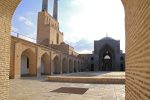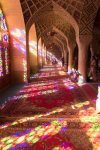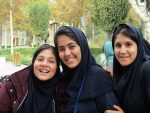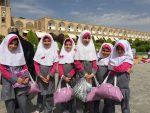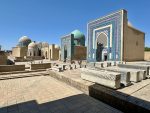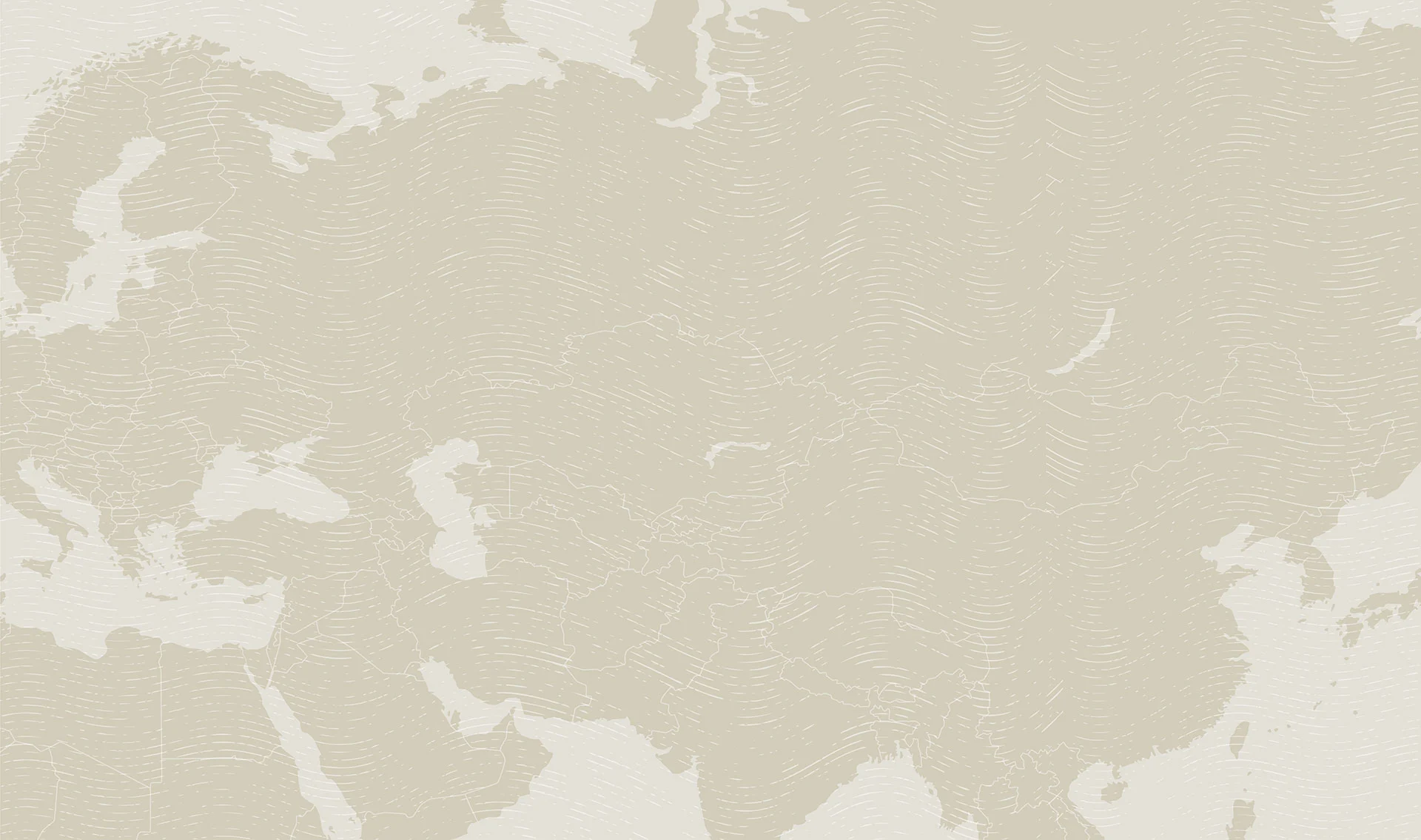Once Forbidden Lands of Central Asia & Iran
Photo credit: Lindsay Fincher
From Tashkent to Tehran via Turkmenistan
Overview
This journey spans three countries and over 2,500 years of history. In Uzbekistan you’ll explore three legendary Silk Road cities, all UNESCO World Heritage Sites. In Turkmenistan you’ll visit ancient Parthian fortresses and a grandiose modern capital built from white marble. And in Iran you’ll experience centuries of spectacular Persian architecture, including one of the world’s great ancient ruins.
Along the way, MIR’s expert guides will immerse you in the culture at bustling bazaars, local restaurants, ceramics studios, and a horse farm specializing in a prized local breed. You’ll experience the boundless hospitality that the people of all three countries pride themselves in, and you’ll see how past and present come together in their daily lives.
Travels to: Uzbekistan, Turkmenistan, Iran
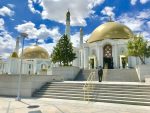
Map

Itinerary
-
Days 1-3: Tashkent (Uzbekistan), Samarakand

The trip begins in Uzbekistan’s capital and largest city, Tashkent, where you’ll discover a mix of traditional and modern landmarks and visit a ceramics master in his studio. Then travel to blue-tiled Samarkand, the conqueror Tamerlane’s legendary capital, hailed by UNESCO as “the crossroad of cultures.” Touring includes stops at massive Bibi Khanum Mosque, gracefully proportioned Registan Square, and Ulug Bek Observatory, the site of crucial discoveries in 14th-century astronomy.
HIGHLIGHTS
- The monumental 16th-century Islamic architecture of Tashkent, including Kukeldash Madrassah, Kaffal-Shashi Mausoleum, and Barak-Khan Madrassah
- Tashkent’s park-like Independence Square—formerly Lenin Square, rechristened and adorned with a new monument following Uzbekistan’s independence from the Soviet Union in 1991
- Discovering the brilliance of traditional Uzbek ceramics in the studio of a sixth-generation master
- UNESCO-listed Samarkand’s central Registan Square, bordered by three beautiful madrassahs
- The 14th-century conqueror Tamerlane’s architectural legacy in Samarkand, epitomized by Bibi Khanum Mosque, in its day the largest mosque in the world
- Ulug Bek Observatory, where Tamerlane’s grandson made historic advances in the study of astronomy
-
Days 4-7: Gijduvan, Bukhara, Khiva

Stop in the town of Gijduvan to tour one of Uzbekistan’s most renowned ceramics workshops. Then it’s on to Bukhara, Central Asia’s most ancient living city. The Old Town, a UNESCO World Heritage Site, encompasses more than 140 protected monuments, including the Lyabi-Hauz Plaza at the heart of the city and the Ark Citadel, Bukhara’s original fortress. Next, head northwest through the Kyzyl Kum Desert to Khiva, the last great oasis on the Silk Road’s northern caravan route. Wander through the winding alleys of the UNESCO-listed Old Town, filled with minarets, cobbled alleys, mosques, and Kunya Ark, once the residence of the ruling khans.
HIGHLIGHTS
- Witnessing the creation of brilliantly colored, intricately ornamented ceramics at the Narzulayev family workshop in Gijduvan
- Bukhara’s evocative Old Town, with its timeless domed bazaars and majestic Lyabi-Hauz Plaza
- Ark Citadel, Bukhara’s giant ancient fortress
- Tasting plov, the quintessential Uzbek rice dish, at lunch in the home of a Bukhara family
- The mix of palaces, mosques, and charming alleyways in Khiva’s Ichon-Qala (Old Town)
- Beautifully preserved Kunya Ark, the original residence of the khans
-
Days 8-9: Dashoguz (Turkmenistan), Ashgabat, Nisa

Cross the border into Turkmenistan and take an hour-long flight from Dashoguz to the capital, Ashgabat, a city of flamboyant gilded architecture built in the aftermath of a devastating 1948 earthquake. A trip outside of town takes you to the ruins of the ancient city of Nisa, a UNESCO World Heritage Site that was once the center of the Parthian Kingdom, and to a horse farm dedicated to the Akhal-Tekke breed.
HIGHLIGHTS
- Exploring the ruins of Nisa’s two fortresses, which show influences of ancient Greek and Roman culture
- Getting to know the region’s elegant Akhal-Tekke horses, one of the oldest cultured breeds in the world, on an owner-led farm tour
- The opulent new architecture of Ashgabat, which holds a Guinness record for highest density of white marble buildings in the world
- The brilliant, handwoven works on display at the National Museum of Turkmen Carpets
- The $100-million Kipchak Mosque, with its 164-foot golden dome and room for 10,000 worshippers, located just outside Ashgabat
-
Days 10-13: Mashad (Iran), Tehran, Yazd

Upon entering Iran, the first stop is the city of Mashad, home to one of the country’s holiest Shi’ite shrines. The following day, take the hour-and-a-half flight to Tehran, the bustling capital, where you’ll get a window into Persian culture at Iran’s finest museums. Another short flight takes you to Yazd, a traditional center of Zoroastrianism. It’s a city of such beauty and cultural significance that UNESCO designates it a World Heritage Site in its entirety.
HIGHLIGHTS
- Mashad’s Imam Reza Shrine, a major pilgrimage site decorated with the work of Al Reza Abbasi, Persia’s most famous calligrapher
- The extensive array of decorative arts, some dating back well over a thousand years, at Tehran’s Reza Abbasi Museum
- Tools of Neanderthals, prehistoric pottery, artifacts from Persepolis, and other archaeological treasures at the National Museum of Iran
- The wide-ranging collection of art and sacred relics, including calligraphy, textiles, carvings, and carpets, at the National Islamic Museum of Iran
- The many treasures of UNESCO-listed Yazd, including the Dowlat Garden, the Friday Mosque, and the Zoroastrian Fire Temple and Towers of Silence
-
Days 14-15: Pasargadae, Shiraz

Departing from Yazd, stop at the ruins of the city of Pasargadae, founded by Cyrus the Great in the 6th century BC, and then arrive in Shiraz, one of Iran’s most beautiful and historically rich cities, renowned for its gorgeous gardens and intricate architecture. In the “City of Roses and Nightingales” you’ll explore a stunning, light-dappled mosque and people-watch at the shrine of a beloved poet.
HIGHLIGHTS
- The limestone mausoleum of Cyrus the Great at the UNESCO-listed ruins of Pasargadae
- The verse-engraved tomb of Iran’s greatest lyric poet, Hafez, a site of pilgrimage and reverence surrounded by a lovely garden and a teahouse
- The exquisite tilework and stained glass at Nasir-ol-Molk Mosque, where sunlight creates an explosion of color
- Shiraz’s Narenjestan Ghavam Museum, a grand 19th-century house set amid meticulously maintained gardens
-
Days 16-18: Persepolis, Isfahan

Proceed onwards to one of the world’s great ancient archaeological sites, Persepolis, the ceremonial city of the Achaemenid Empire. Then it’s on to one of Iran’s great living cities, Isfahan, where beautiful, historic public spaces buzz with activity. Stroll through the centerpiece, UNESCO-listed Imam Square, and explore the spectacular buildings that surround it—the Imam Mosque, the Sheikh Lotfollah Mosque, and the Ali-Qapu Palace. Other Isfahan attractions include the Friday Mosque, the elegant bridges over the Zayandeh River, and the Armenian and Jewish quarters.
HIGHLIGHTS
- The ornate columns and beautifully rendered bas-reliefs of the vast, UNESCO-listed Persepolis archaeological site
- Taking in the scene at Isfahan’s 22-acre Imam Square, one of the largest city squares in the world
- The turquoise minarets and intricate tilework of the magnificent Imam Mosque
- Eight hundred years of Persian architecture on display at UNESCO-listed Friday Mosque, the largest and most eclectic mosque in all of Iran
- Discovering the legacies of minority cultures in Isfahan’s Armenian and Jewish quarters
-
Days 19-20: Kashan, Tehran

On the way back to Tehran, stop in the oasis city of Kashan, located on the edge of the Dasht-e Kavir salt desert. It’s famed for UNESCO-listed Bagh-e Fin, a spectacular Persian garden, and for its beautiful 19th-century merchants’ houses, some of which are now open to the public. After a night in Tehran, depart the following day.
HIGHLIGHTS
- Discovering opulent courtyards hidden behind the modest facades of Kashan’s grand homes
- The meticulous symmetry the late-18th-century Agha Bozorg Mosque, designed by the revered architect Ustad Ali Maryam
- The beautiful, brilliantly engineered waterworks at Bagh-e Fin
Dates & Prices
Small group tour – max 16 travelers
Land tour price, per person. Based on double occupancy and minimum group size of 5 travelers.
Call for dates and prices
What's Included
-
Tour Includes
- Accommodations, as noted in the itinerary.
- Meals as noted in the itinerary: 19 breakfasts, 17 lunches and 14 dinners.
- Restaurant tips for included meals.
- Services of experienced, English-speaking local guides, drivers and other staff, including a MIR Tour Manager.
- Arrival/departure airport transfers. MIR will arrange for all travelers to be met on arrival and seen off on departure whether we make your airfare arrangements or not, provided you arrive and depart on the tour start/end dates in the tour start/end cities.
- Ground transportation throughout itinerary by private coach or van (size of vehicle depends on group size).
- Guided sightseeing tours and entrance fees as outlined in itinerary.
- Special events, excursions, and cultural performances per the itinerary.
- Baggage handling where available.
- Gratuities to local guides, drivers, porters, and other service personnel.
- Complete pre-departure electronic document that includes detailed packing suggestions, reading list links, country-specific information, maps, travel tips and more.
- Customized visa application and instruction kit (please note, visa fees are not included in the tour price).
- Electronic final update bulletin, with any late news, updates and important information.
-
Not Included
- Internal airfare (internal airfare is quoted separately and is subject to change by airlines).
- International airfare or taxes/fuel surcharges.
- Meals not specified as included in the itinerary.
- Single supplement charge, if requested or required.
- Travel entry pass to Turkmenistan payable on arrival, currently $12-$15, subject to change.
- Items of a personal nature (phone calls, email, laundry, alcohol, excess baggage, etc).
- Gratuities to Tour Manager.
- Visa/passport fees, airport departure fees.
- Expenses incurred as a result of delay, modification or extension of a tour due to causes beyond MIR’s control.
- Travel and trip cancellation insurance.
Activity Level
-
Level 3: Medium
Level 3: Medium
This small group tour features long days walking and standing while touring, some long segments of overland and occasionally rough travel, uneven surfaces and steps, absent handrails, some stair-climbing, and absence of elevators. Only those fit to travel, who are willing to accept local standards of amenities and services and physical challenges of the program should consider joining this program.
Travelers must be able to walk at least two miles a day, keeping up with fellow travelers. There are overall shortcomings in the tourism infrastructure, including some that can cause walking challenges, such as unpaved sidewalks, uneven surfaces and steps, packed-dirt streets, broken pavement (streets or sidewalks) and a general absence of handrails or ramps. Some attractions are only accessible via steep staircases with tall uneven steps – these additionally may be spiral staircases, in narrow passages with limited light. Elevators are not available at touring sites, nor at a few of the hotels.
Past travelers have also encountered challenges with plumbing, bureaucratic service, variety of locally available foods, availability and quality of public restrooms.
Accommodations vary from superior tourist class hotels to small, intimate properties.



